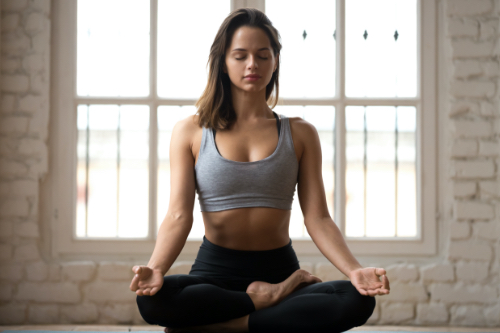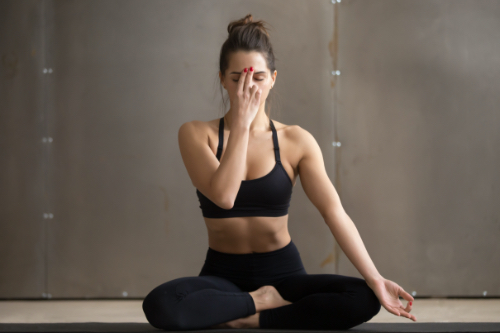
Yoga
Benefits of Yoga
- A sustained practise results in weight loss
- Improved blood circulation, which improves skin quality and texture
- Delays overall ageing and is therapeutic by nature
- Improves physical stamina
- Good for gut health and improved digestion
- Enhances fertility and reproductive health
- Improves sleep cycle
- It makes you calm and happy
- Improves concentration
- Reduces stress
- Improves immunity
Different Types of Yoga

Hatha Yoga
The Sanskrit word Hatha means “force.” Therefore, hatha yoga restores the balance of the body. This type of yoga works on the harmony between the chakras and energy points. The chakras are vortexes of energy or the points in our body where the energy lies concentrated. They are present in seven different locations in the body and connect to specific organs and glands.
Hatha yoga comprises many physical postures and positions that balance the body and mind. Different types of yoga by various schools and teachers have certain fundamental commonalities.

Ashtanga Yoga
Ashtanga yoga is a direct offshoot of sage Patanjali’s Yoga Sutras. Famous as the yoga form for weight loss, the ashtanga word is a derivative of the word eight in Sanskrit.
Ashtanga yoga has eight pillars: Principles, personal discipline, asana and postures, pranayama, withdrawal, concentration, meditation and salvation.
If you are looking for yoga for anxiety and stress relief, upper back pain, lower back pain, or fat loss, ashtanga would be the best for you.

Vinyasa Yoga
This form of yoga is also called “flow” yoga. The word “Vinyasa” has two parts, with Vi meaning variation and Nyasa meaning within prescribed limits.
Vinyasa yoga incorporates movement and breathing techniques. It creates a flow of postures with controlled breathing replicating the flow of life. For example, Vinyasa yogis initiate the flow with a child’s pose and terminate the flow with the death pose (the savasana). The transitions into each posture reflect the movement through life. Meditation is a part of advanced vinyasa yoga practices, making the form more mindful.

Kundalini Yoga
Also known as the “yoga of awareness,” kundalini yoga includes repetitive poses. Kundalini yoga awakens the latent kundalini Shakti. This spiritual energy resides at the base of the spine. Yogis believe that Kundalini Shakti is like a coiled snake, unaroused at the base of the spine. Therefore, the active energy moves up the spine and contributes to your spiritual well-being. Kundalini yoga is also suitable for stress, anxiety, depression and better cognitive function.
Movements begin with a chant, followed by pranayama, the act of controlled and precise breathing. Then comes kriya, a set of postures or mudras (specific hand positioning). Then one performs pranayama, chanting, and meditation.
Iyengar Yoga
This type of yoga is quite similar to vinyasa yoga. It gets its name from B.K.S. Iyengar, one of the foremost yoga teachers in the world. Iyengar yoga is different from other types of yoga. It focuses primarily on posture, body alignment and opening of the body. It also uses props such as yoga blocks and belts to perfect poses.
Benefits
- Increase Flexibility
- Toned muscles
- A calmer mind
- Pain relief
- Improved posture and alignment
- Protection from disease
- Improved breathing
- Strengthen the muscles
Aerial Yoga
It is suitable not only for advanced people but also for beginners. It helps to build toned and lean muscles. As opposed to traditional yoga, aerial yoga also incorporates other exercises-all while defying gravity. It has the goodness of yoga and cardio exercises like swimming or running.
In this particular yoga, a rope suspends our body in the air, and poses are introduced hereafter.
Benefits
- Burns body fat
- It improves flexibility
- Cures breathing difficulties
- Provides relief from stress
- Increases core strength
- Improves posture
Iyengar Yoga
This type of yoga is quite similar to vinyasa yoga. It gets its name from B.K.S. Iyengar, one of the foremost yoga teachers in the world. Iyengar yoga is different from other types of yoga. It focuses primarily on posture, body alignment and opening of the body. It also uses props such as yoga blocks and belts to perfect poses.
Benefits
- Increase Flexibility
- Toned muscles
- A calmer mind
- Pain relief
- Improved posture and alignment
- Protection from disease
- Improved breathing
- Strengthen the muscles
Aerial Yoga
It is suitable not only for advanced people but also for beginners. It helps to build toned and lean muscles. As opposed to traditional yoga, aerial yoga also incorporates other exercises-all while defying gravity. It has the goodness of yoga and cardio exercises like swimming or running.
In this particular yoga, a rope suspends our body in the air, and poses are introduced hereafter.
Benefits
- Burns body fat
- It improves flexibility
- Cures breathing difficulties
- Provides relief from stress
- Increases core strength
- Improves posture
Four Main Paths of Yoga
Karma Yoga
Karma yoga is one’s path of devotion to selfless work. In other words, it is a yoga of action. It signifies that one has to devote time, energy, and effort to any task. There should not be any expectation of a reward or approval. It is considered a humbling practice as one works not for the ego but the greater good.
Jnana Yoga
Jnana yoga is the yoga of intellectual knowledge and practical wisdom. This form is all about self-realisation through meditative awareness. One experiences knowledge and develops intuitive understanding. One learns to separate the ego from the true Self.
Raja Yoga
Raja Yoga means king in Sanskrit. Raja Yoga is also known as ‘classical yoga’, ‘king of yogis’ or ‘yoga of the mind’. It is also called ashtanga yoga.
Bhakti Yoga
Bhakti comes from bhaj, which means to worship or love God. Some people consider bhakti-yoga a way to liberate themselves from the eternal birth and death cycle. Treading this spiritual path helps unite one’s soul or ‘atman’ with Brahman or ‘true reality.’
